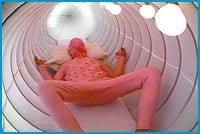
HOW SHALL I LOVE YOU, MY NEW LITTLE ONE? A gloriously surreal and camp vision of our dystopian future.
Puerto Rican-American artist Miguel Ventura’s How Shall I Love You, My New Little One? is a spectacular half-hour video version of an elaborate performance/installation mounted in 2002 in Mexico City. It is just one manifestation of a complex, burlesque-fascist system that Ventura invented — as stylized and clinical in its choreography as anything devised by Matthew Barney — dubbed the New Interterritorial Language Committee (NILC). Set in a post-revolutionary world where the NILC rules, every space in Ventura’s universe is white and sterile, and the figures within it wear identical blond wigs, at once Aryan and cherubic.
Apparently inspired by David Cronenberg’s The Brood, the plot involves a suffering middle-aged man (the artist) consulting with an abusive psychiatrist (played by a young actor) who urges him to generate a new and universal language — evidently a common, if ridiculous, prescription. This conception is achieved by consuming 30 medicinal brown cookies shaped like the squiggly glyphs of the NILC alphabet. After struggling to consume all of these foul, fecal treats, the ailing man crawls into a cocoon-like tent and undergoes a series of corporal mutations (reminiscent of Leigh Bowery costumes): First into a pregnant figure with a Technicolor maternity dress and a head made of turds, then a large pink eggsac and, finally, after expelling a heap of colourful plush babies in the shapes of the NILC glyphs (this strange code repeats throughout Ventura’s work), the man becomes a multinippled feeding machine hooked up to its orthographic young. With this disturbing queer take on reproduction and excretion, the hero’s transformation into a new language/body is complete.
What is most fascinating about Ventura’s wildly imaginative and eccentric practice is the intricacy and detail of this bizarre future world he has created, governed by convoluted fictional languages that the artist has methodically catalogued. This polymorphously perverse zone may be exaggerated, but it is built from prescient references to authoritarian social structures, parodying the often obscene ways that power works. This surreal, highly regimented dystopia is populated by grotesque creatures and rendered with a gloriously camp, even infantile sensibility. It is alternately exhilarating and head-scratching.
The deity of Ventura’s perverse cosmology is Daniel Paul Schreber (author of Memoirs Of My Mental Illness), who imagined himself morphing into a woman to give birth to a brand new race of humans. Ventura’s alter ego, in fact, is Schreber’s obscene mother fantasy come to life: One Heidi Schreber, a crazed, braided drag queen — and Teutonic caricature — who generates the NILC alphabet in Ventura’s video, Exercises Or Return Of The Body, which was shown at Inside Out film fest in 2006.
Ventura’s sublime sci-fi oddity screens at Vtape as part of the show The Symptom Or The Cure? Reconfigurations Of The Post-Mexican Imaginary, curated by Irmgard Emmelhainz. Also featured are 90 minutes of equally queer and baroque videos by performance art icon and “inter/transcultural poltergeist” Guillermo Gómez-Peña. His hilarious and incisive Spanglish diatribes and carnivalesque, postmodern mash-ups of Chicano stereotypes go well with Ventura’s kitsch totalitarian theatrics. Both make mincemeat of our “paranoid and binary post-9/11 world.”


 Why you can trust Xtra
Why you can trust Xtra


